Should I Use Screws Or Nails For Subfloor

This commodity is office of our series on How to Install Hardwood Floors.
While preparing to lay 1100 square feet of hardwood flooring, we discovered pregnant variation in the OSB subfloor that will serve equally the nailing surface for the hardwoods. This commodity provides detailed instructions for leveling a subfloor based on our project.
Project Overview: Uneven OSB Subfloor
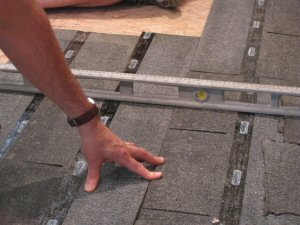 The subfloor beneath our first floor is 5/8″ oriented strand lath (OSB) laid over ii x 10 joists that are spaced 16 inches on-center (o.c.). The joists run from the forepart of the firm to a steel I-beam in the heart of the firm, and then from that I-beam to the back wall. Each span is approximately 14 feet.
The subfloor beneath our first floor is 5/8″ oriented strand lath (OSB) laid over ii x 10 joists that are spaced 16 inches on-center (o.c.). The joists run from the forepart of the firm to a steel I-beam in the heart of the firm, and then from that I-beam to the back wall. Each span is approximately 14 feet.
Before nosotros pulled up the previous flooring surfaces (rug and vinyl), we knew there were some spots on the subfloor with significant peaks and valleys. Our kitchen, for example, had a noticeable dip effectually a cabinet peninsula. We think the house was built with 'dark-green' lumber that may have been exposed to wet before information technology was installed. When it stale, the bowing became very noticeable.
Also, every slice of dimensional lumber has a natural crown to information technology (the direction it bows along the long border of the wood). The joists should have been laid such that all the wood was "crown up," but we suspect that several of the joists were incorrectly installed "crown downwardly." When this happens between two joists that are "crown up," the depression tin be meaning.
The depth error in the worst spots on the floor was equally much as three/iv″ over near 4 feet. This is well exterior the tolerance for hardwood floor, which should be no more than three/16″ variation over 8 anxiety. Y'all can see the dramatic slope on simply i office of the floor in this picture. The level is sitting on the crown peaks, with the same measure in a depression between them.
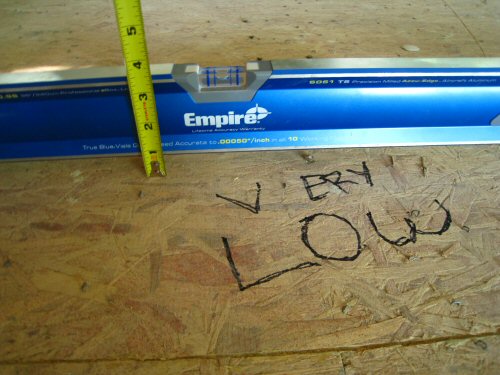
What is surprising about this floor is that the actual OSB is in very adept shape. Sometimes, you lot'll find OSB swelling at the joists where moisture contacted the subfloor. This wasn't the case in this house. We did have to supercede one piece of OSB due to woods rot where a persistent leak existed, but the rest of the floor was in pristine condition.
If you're dealing with a swelled OSB state of affairs, we remember the best course of action is to use a belt sander to grind down the swelled edge. Only make certain this doesn't cause any structural instability. If the piece is rotted or merely beyond reasonable repair, the best course of activeness is replacement.
The Solution for Leveling a Subfloor
Searching around the internet for solutions, we eventually landed on this article from Inquire the Builder that suggests using structure felt and asphalt roofing shingles to level an uneven plywood or OSB flooring for hardwood installation. This was a novel thought to us, but it made sense. Both roofing shingles and construction felt are dense, non prone to compression (a key element for leveling), and sufficiently sparse that they can be used every bit incremental steps to get to a flat surface.
Since nosotros have such dramatic slopes on the floor, we decided to apply the shingles and construction felt solution along with a new layer of 3/eight″ plywood. We chose 3/8″ plywood because it is rigid enough to absorb very pocket-sized depressions underneath it, and not so heavy equally to be unwieldy.
Nosotros are planning to lay iii/4″ exotic hardwoods on top of the plywood, then what we're looking for from the new plywood isn't an "ultra-rigid" surface, information technology simply needs to bond to the layer beneath information technology, absorb very pocket-size gaps where the leveling provided by the construction felt and shingles isn't perfect, and allow sufficient "grab" past subfloor screws to get a tight bail with the 5/eight″ OSB beneath.
To fasten the plywood to the OSB, we considered using a combination of 2″ subfloor screws and construction adhesive (i.e., Liquid Nails for Subfloors). This is generally referred to every bit "gluing and screwing," and yous'll see it suggested on some ceramic tiling sites equally a method to increase the rigidity of a floor for tile installation. Since nosotros're going to be laying the iii/4″ hardwoods on meridian, which itself will entail 15 gauge staples more or less every xviii inches on the flooring, nosotros decided to omit the construction agglutinative and instead go simply with the screws. Our primary motivation was speed and less mess, and and so far after walking on the floor, we're happy with the result.
For the subfloor screws, we used a Senco Screwgun (reviewed at that link) to fasten the three/viii″ plywood to the OSB. The screwgun is an absolute must for this job. We put a screw in approximately every 1 foot square, which ways approximately 1100 screws on this floor. Driving with a drill-driver is simply non an efficient pick.
Alternatives to Shingles and Plywood for Leveling
Before getting into all the details of the leveling job, I should say there are other options for leveling a floor. For instance, nosotros could accept pulled upwardly the OSB, shimmed the joists underneath, and refastened the OSB to the shimmed joists. This would have the reward of non putting any boosted load on the subfloor, and addressing the crusade of the trouble straight at the root.
In our situation, all the same, we believed that this try would be much more pregnant than a new layer of 3/8″ plywood, because the problem was pervasive throughout the floor in varying degrees, and as you lot'll see from the pictures below, the shingles give a lot of options for how to accost a gradient over a broad range of flooring. If we were dealing with a single, pregnant depression in one or 2 parts of the floor caused by joists being incorrectly crowned, we probably would have opted for this solution since it is much less expensive.
There's besides self leveling physical equally an pick for leveling a subfloor. We used self leveler to level the concrete slab in our basement with great success. We opted confronting this solution on the first floor because nigh self levelers aren't rated for installation over OSB, and because they are expensive and messy. Plus, we figured we would need to install 3/8″ plywood over the self leveler to set for hardwoods (this may have been overkill, just we weren't comfy with the solution of driving staples directly through the leveler). Effectively, the asphalt shingles in our solution are a rigid leveler that we think works too as any liquid self leveler would accept, and they are easier to control. If y'all've never worked with self leveler, information technology is a miracle product, just it has its drawbacks, including short work times.
Tools Required for Leveling a Floor with Plywood and Shingles
- 8 pes level – for getting an idea of where the high and low spots are on the floor.
- 4 pes level – for moving in tighter areas and judging how level a local expanse is.
- String and nails – for pulling a string above the floor both before and later on the installation to get floor-wide perspective on the problem.
- Utility knife with roofing blade (2 knives are nice if yous're working with two people).
- Tape measure
- Circular saw (recommended) and/or table saw for cut plywood.
- Screwgun (we like this Senco Screwgun with square head driving bit).
Materials Required for Leveling a Floor
- Asphalt roofing shingles – the 3-tab kind that are almost one/16″ thick (cheapest bachelor is best). You can find these at Domicile Depot, Lowes, roofing supply stores, and other home stores.
- three/viii″ plywood – this will be sold as 11/32″ plywood. Y'all will need a sufficient corporeality to cover the subfloor.
- ii″ or 2.v″ collated subfloor screws for the screwgun – nosotros used square-head screws – expect 1 screw per square foot.
- xxx lb. construction felt.
Steps for Leveling a Subfloor
Preparation: Ensure the subfloor is clear, clean, and free of debris, with enough of space to work. Remove molding and baseboard at the edges and then you lot can become the plywood shut to the walls.
Step one: Make up one's mind and mark high and depression spots across the floor. We did this ii means, first by dragging our 8 foot level across the floor to try to determine where the loftier and low spots were in local areas, and then by stretching a string across the whole floor, secured past a nail on each end. The string does a better job of showing high and low areas across the whole floor. We marked high and low spots using a non-scientific method, sharpie marker on the flooring with the words "high" and "depression" and sometimes "very low" in the worst spots.
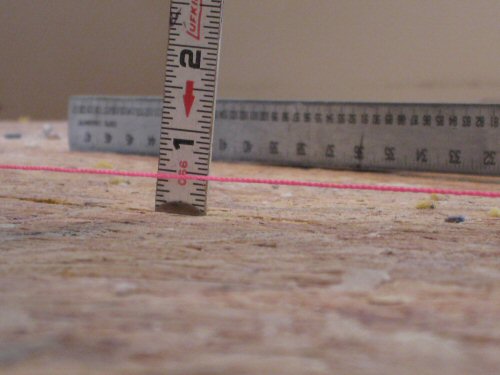
Step 2: Set a strategy for filling in depression spots to "even out" the flooring. The floor doesn't have to be level, it has to exist flat. Also, it doesn't have to exist perfectly flat – 3/16″ rise or autumn over an 8-ten foot area is acceptable. We decided to get-go at ane end of the floor near the fireplace that had a meaning low expanse and a nearby high area. About the front of this fireplace, the low is almost 3/4″, so we'll have to stack the shingles over ane another.
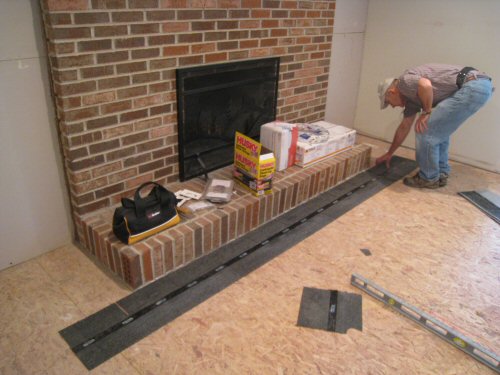
Step 3: Fill in low spots with shingles and construction felt. For our efforts, we decided to utilize shingles exclusively under the 3/eight″ plywood, with the possibility of using the structure felt betwixt the 3/8″ plywood and the hardwoods if necessary. This can be hard to go perfect, and we plant ourselves often going back and along between our eight human foot and 4 foot levels.
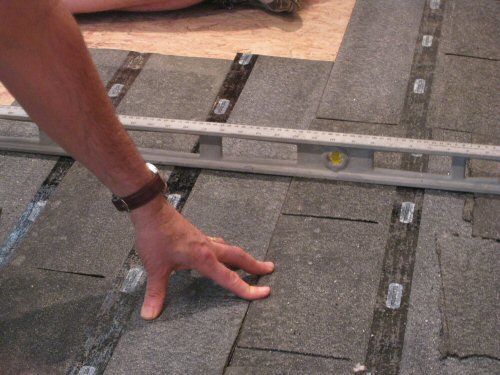
If you picture the floor as a topographical map, the idea is to try to make full in the low spots, which may require overlapping some shingles to get to the right depth, and volition certainly require cuts… particularly since y'all are ever leveling in two dimensions. You can moving picture that if you lot were filling a perfectly round depression, yous would probably start in the very middle and work your style out, layering shingles until you get a perfectly flat surface.
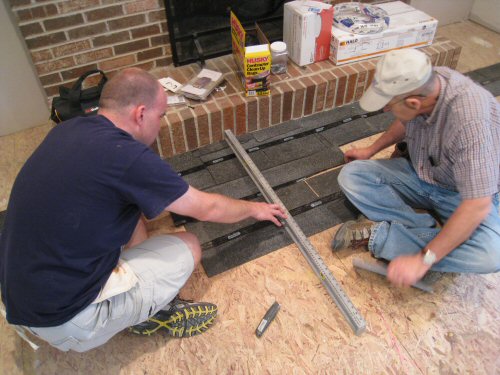
Step iv: One time the low spots are filled in with shingles, fasten 3/8″ plywood to the surface using 2″ or 2.5″ subfloor screws. Effort to striking the joists as oft as possible and put the screws about every 12-xiv″ along the perimeter and most one time every square foot in the field. In this picture, Ethan is checking to sure that the shingles underneath my feet are filling the gap in the floor correctly.
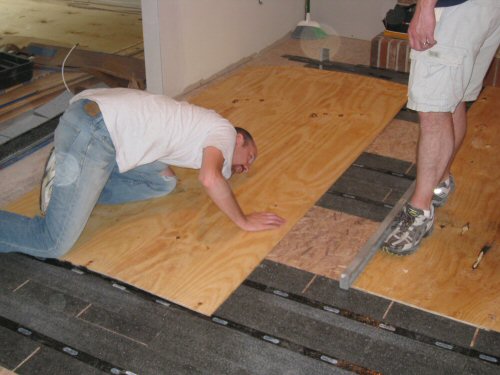
We found information technology best to "dry fit" the plywood in identify first, walk on information technology and take some other person utilize the level to check for compatible flatness. One time you lot start putting screws in, you'll eventually create a very hard sail to remove (remember, each piece of plywood ends upwards with about 45 screws in it if you screw every 12 inches square and along the perimeter).
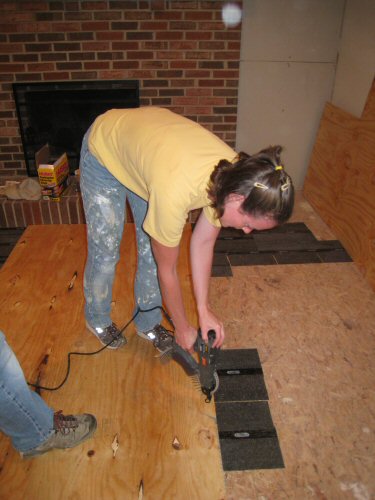
Stride 5: Continue moving out from the starting time piece of plywood, continually leveling and re-evaluating extended areas of the floor. It is a expert idea to regularly check and re-bank check the meridian of the floor and to make certain that seams between the pieces of plywood exercise not create ridges. Much like regular tongue-and-groove plywood on joists, we recommend staggering the joints on the long edge.
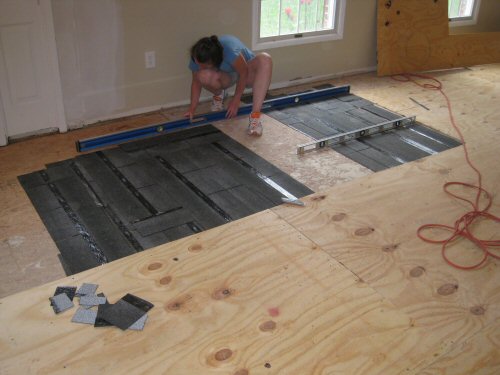
Step vi: Repeat steps iii-v throughout the rest of the floor.
Floor Loading / Weight Considerations
Whatever fourth dimension you are adding weight to a floor, in that location can exist a loading concern. About modern homes are congenital to handle forty lbs. / square human foot average loading, but every house is different, and your individual state of affairs could be very different. 3/viii″ plywood weighs about 1.5 lbs. / square foot, so we were not concerned about it. Asphalt shingles tin can get heavy, however, especially when filling in a low spot. We think the most weight that would be placed across a single joist with the shingles is about 15-25 lbs forth the span, or well-nigh iii-4 lbs. per foursquare pes.
In general, plywood does not add together force to a floor, except that it tin help distribute the load from the center of a floor to the edges and to nearby joists, which tends to increment strength a bit. If you are at all concerned, it is wise to consult with a structural engineer before trying this in your own dwelling house.
Additional Thoughts & Tips
- Try to avoid relying on the 3/8″ plywood to level the flooring. iii/eight″ plywood will span about a 1 inch gap earlier it exhibits considerable localized weakness… Instead, try to use the shingles and/or construction felt to eliminate air gaps between the truthful subfloor and the boosted iii/8″ plywood layer.
- Remember that the subfloor beingness "level" is considerably less important than being "flat" – if there'south a slight incline (3/16″ or less) over 8 anxiety, that will likely exist imperceptible to visitors and you especially once piece of furniture is placed in the room.
- Remember of the project as trying to "smoothen out" hills and valleys in the floor to acceptable tolerances. Nothing has to exist perfect.
- Programme to lay the hardwood floors across the joists rather than parallel to them. This will further reinforce an fifty-fifty flooring surface.
Does it Piece of work?
Admittedly. Accept a expect at the finished floor in this space. It's beautiful, and almost perfectly apartment. We've had the floor installed for 1-1/2 years at present and have had no problems with leveling. Guests curiosity at the new floor, not knowing all the piece of work that went into the installation.
Source: https://www.oneprojectcloser.com/how-to-level-a-plywood-or-osb-subfloor-using-asphalt-shingles-construction-felt/
Posted by: cooperabelity.blogspot.com


0 Response to "Should I Use Screws Or Nails For Subfloor"
Post a Comment